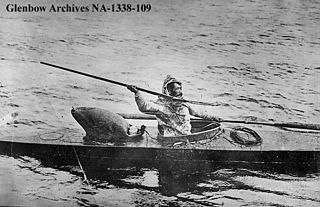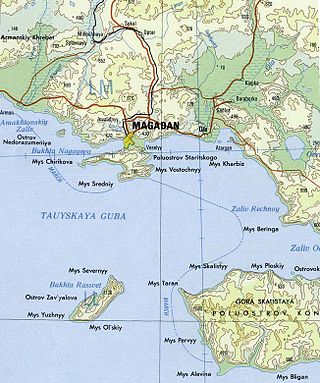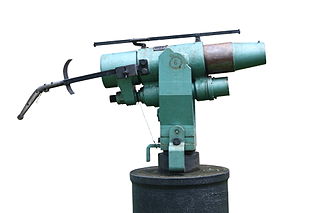Related Research Articles
The Thule or proto-Inuit were the ancestors of all modern Inuit. They developed in coastal Alaska by the year 1000 and expanded eastward across northern Canada, reaching Greenland by the 13th century. In the process, they replaced people of the earlier Dorset culture that had previously inhabited the region. The appellation "Thule" originates from the location of Thule in northwest Greenland, facing Canada, where the archaeological remains of the people were first found at Comer's Midden.

A harpoon is a long, spear-like projectile used in fishing, whaling, sealing, and other hunting to shoot, kill, and capture large fish or marine mammals such as seals, sea cows, and whales. It impales the target and secures it with barb or toggling claws, allowing the fishermen or hunters to use an attached rope or chain to pull and retrieve the animal. A harpoon can also be used as a ranged weapon against other watercraft in naval warfare.

A whaleboat is a type of open boat that was used for catching whales, or a boat of similar design that retained the name when used for a different purpose. Some whaleboats were used from whaling ships. Other whaleboats would operate from the shore. Later whaleboats usually could operate under sail or oar - American whaling crews in particular obtained better results by making their first approach to a whale under sail, then quickly unstepping the mast and using oars thereafter.

Essex was an American whaling ship from Nantucket, Massachusetts, which was launched in 1799. On November 20, 1820, while at sea in the southern Pacific Ocean under the command of Captain George Pollard Jr., the ship was attacked and sunk by a sperm whale. About 2,000 nautical miles (3,700 km) from the coast of South America, the 20-man crew was forced to make for land in three whaleboats with what food and water they could salvage from the wreck.

The Ann Alexander was a three-masted ship from New Bedford, Massachusetts. She is notable for having been rammed and sunk by a wounded sperm whale in the South Pacific on August 20, 1851, some 30 years after the famous incident in which the Essex was stove in and sunk by a whale in the same area.

A whaler or whaling ship is a specialized vessel, designed or adapted for whaling: the catching or processing of whales.
Whaling in Norway involves hunting of minke whales for use as animal and human food in Norway and for export to Japan. Whale hunting has been a part of Norwegian coastal culture for centuries, and commercial operations targeting the minke whale have occurred since the early 20th century. Some still continue the practice in the modern day, within annual quotas.

Nedorazumeniya Island is an island on the north coast of the Sea of Okhotsk. It lies on the north side of Taui Bay, between Amakhton Bay to the west and Nagaev Bay to the east. It is about 20 kilometres (12 mi) west of the city of Magadan.
A Nantucket sleighride is the dragging of a whaleboat by a harpooned whale while whaling. It is an archaic term from the early days of open-boat whaling, when the animals were harpooned from small open boats. Once harpooned, the whale, in pain from its wound, attempts to flee, but the rope attached to the harpoon drags the whalers' boat along with it. The term refers to Nantucket, Massachusetts, the center of the American whaling industry; as well as the speed associated with riding in a horse-drawn sleigh. The term wasn't used by whalemen themselves, but was probably invented by a late 19th-century journalist.

Sperm whaling is the human practice of hunting sperm whales, the largest toothed whale and the deepest-diving marine mammal species, for the oil, meat and bone that can be extracted from the cetaceans' bodies.
A whaler is a specialized kind of ship designed for whaling.

Two Brothers was a Nantucket whaleship that sank on the night of February 11, 1823, off the French Frigate Shoals. The ship's captain was George Pollard, Jr., former captain of the famous whaleship Essex. The wreck was discovered in 2008 by a team of marine archaeologists working on an expedition for the National Oceanic and Atmospheric Administration in the Papahānaumokuākea Marine National Monument. She is thought to have been built in 1804 by Joseph Glidden in Hallowell, Maine.

Down to the Sea in Ships is a 1949 American seafaring drama film directed by Henry Hathaway, starring Richard Widmark and Lionel Barrymore. The supporting cast includes Dean Stockwell, Cecil Kellaway, Gene Lockhart, and John McIntire. There is no connection between this picture and the silent film by the same name; the only thing they have in common is the title and the setting.

A harpoon cannon is a whaling implement developed in the late 19th century and most used in the 20th century. It would be mounted on the bow of a whale catcher, where it could be easily aimed with a wide field of view at the target. Powered by black powder and later, smokeless powder, it would generally fire a large steel harpoon, either solid steel or fitted with an exploding black powder, or later, penthrite (PETN) grenade.
George Pollard Jr. was the captain of the whalers Essex and Two Brothers, both of which sank. Pollard's life, including his encounter with the sperm whale that sank Essex, served as inspiration for Captain Ahab, the whale-obsessed character in Herman Melville's Moby-Dick.
Amos Peters Smalley (1877–1961) was a Native American whaler, fisherman, and fish peddler.

Petrel was a whaler, built in Oslo, in 1928, in operation in the waters around Antarctica for over three decades.
"Fast-Fish and Loose-Fish" is chapter 89 of Herman Melville's 1851 novel Moby-Dick, in which Ishmael, the book's narrator, explains the concept of "Fast-Fish" and "Loose-Fish." If a whale, whether dead or not, is marked by a ship's crew with anything to claim it, such as a harpoon or rope, it is a "fast-fish", that is, it must be left alone by other whalers; if it is not so marked, it is a "loose-fish", which can be claimed by any ship that finds it. The clarity of this doctrine, Ishmael says, prevents disputes from escalating into violence. He describes court cases dealing with disputes between crews of whaling ships, and then extends the concept to society and politics, questioning the concept of ownership and the right to possession.

Paledang, peledang, or pledang is a type of Indonesian sailing vessel used for aboriginal whaling from the communities of Lamalera and Lamakera in the islands of Lembata and Solor, respectively. It is propelled by sails made from woven pandan leaves and by paddles. The boat is equipped with a bamboo harpoon, whose hook is attached to the boat using the "sacred rope" called leo, which is made from the leaves of the gebang palm and fiber from waru bark. The boat's crew of around 6 to 10 people also wear a leo aka sacred rope made from cotton and turi bark for luck. The person tasked with the harpoon is called the Lamafa, a position of great importance. Alongside him is an assistant who handles the leo, who also has a high status along with the person who controls the boat. Paledang are made by traditional boat-makers called the Ata Molan. He decides on which part of a hunted whale goes to which crew member.
References
- ↑ The Kendall Institute (2001). "Harpooners & Boatsteerers". Archived from the original on 2008-11-21. Retrieved 2008-08-13.
- ↑ "Nantucket Whaleboat Adventure Rowing Club". Archived from the original on 2008-09-05. Retrieved 2008-08-13.